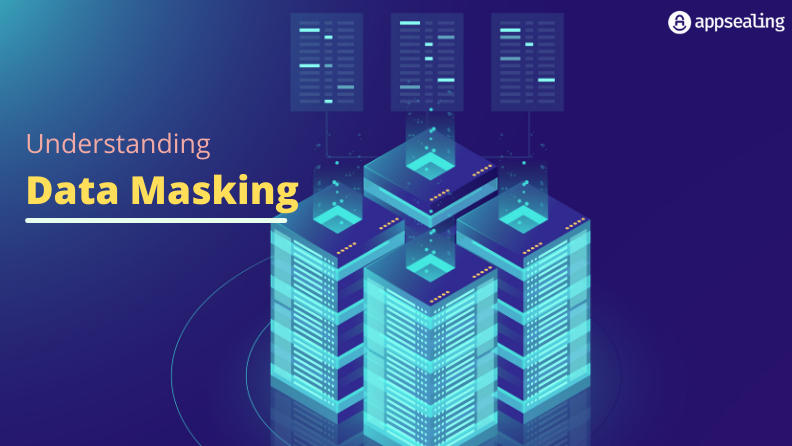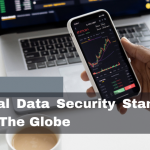With the proliferation of mobile devices, applications have become an indispensable part of modern lives. From grocery shopping to internet banking, people rely on applications and websites for pretty much everything. Needless to say, a huge amount of data is stored and exchanged resulting in the need to protect data at all stages.
With regulations and compliance rules laid out by authorities to ensure data security, enterprises have resorted to several methods of data protection. Data masking is one such technique of protecting data from unauthorized users. This article will shed light on data masking, its types, applications, benefits, best practices and more. Let’s dive in.
Ready to protect your app?
Start 30-days FREE TRIAL. No credit card required. Deliver Secure Mobile Apps Faster in minutes with the leader in application security.

What is Data Masking?
Data masking is the process of creating a replica of organizational data by protecting sensitive data so it is rendered useless for unauthorized users and hackers. This copied dataset is a realistic version that can be used for software testing, sales demo and training purposes. So while data masking alters sensitive data, it still upholds the original characteristics of the data.
Data is required for a variety of purposes but it isn’t a practical and safe option to use production data every time for testing or training. With data masking, the values are changed such that tests performed on the new dataset would yield the same results as they would on the original dataset. If exposed to hackers, the data wouldn’t expose any sensitive information.
Importance of Data Masking
Data masking ensures that sensitive information isn’t available beyond the production environment. A substitute is created so data can be made available for database administrators or test teams without compromising the security. Listed below are a few reasons why data masking is important:
- Copies of production data are often used in non-production environments for application development and testing and personnel training. Data masking is essential to protect sensitive data when used in non-production environments.
- Insider threats cannot be overlooked and data masking serves as an effective remedy against data breaches from unintentional employee actions or compromised insiders.
- Data masking also reduces data risks arising from the use of cloud technologies.
- Data loss, account compromise, data exfiltration and insecure interfaces are serious threats faced by organizations. Data masking ensures protection against these threats.
- Data masking is highly effective for data sanitization. Data sanitization refers to replacing old values with masked values so traces of data cannot be misused even after deletion of files.
What Type of Data Requires Data Masking?
Data masking is critical for protection of three types of data. Listed below are the types of data that must be secured with data masking:
1. Personally Identifiable Information (PII)
Data that reveals the identity of a person comes under personally identifiable information. Such data must be protected with data masking.
2. Protected Health Information (PHI)
Such data is usually collected by healthcare providers. PHI includes demographic information, medical history, medical reports, insurance information of patients among others.
3. Payment card information (PCI-DSS)
Organizations that deal in storage and transmission of payment card information must implement data masking as a security best practice. PCI DSS is a security standard governing methods to handle payment data.
4. Intellectual property (IP)
Any originally created work such as artistic works or new inventions can be protected with data masking.
What are the types of data masking?
There are several types of data masking one can use to safeguard sensitive data. Below mentioned are the most common types of data masking:
1. Static data masking
Static data masking refers to creating a sanitized copy of a production database. The process involves three steps: creating a backup copy of production data and transferring it to another environment, discarding unwanted data and masking the data while it is in stasis. The masked data can then be saved to the desired location.
2. Deterministic data masking
Here, one value in the database is replaced with another value such that the replaced value appears everywhere. For example, you could replace the name ‘Mark’ with ‘John’ in one table and all associated tables would show John instead of the original name Mark.
3. On-the-fly data masking
This refers to masking of data during transfer from production to test or development environment. Here, data masking occurs before it is saved to disk. For organizations that deploy software continuously, it isn’t practical to create a backup of the source database every time. On-the-fly masking enables smaller subsets of masked data to be sent whenever required. It is an effective method to continuously transfer data to non-production environments.
4. Dynamic data masking
This type of masking doesn’t require secondary data storage but needs a reverse proxy. Data isn’t masked while it’s still in the database. Instead, it’s masked on demand and sent over to the dev/test environment. Unmasked data always stays protected from unauthorized access.
Techniques of Data Masking Techniques
There are multiple ways to mask data. Let’s look at the different techniques employed by organizations to achieve data masking.
1. Encryption
Encryption ensures data is not comprehensible for unauthorized users and hackers with the use of an encryption algorithm. Only users with the decryption key can make sense of the data. It is one of the most secure ways of masking data. Managing the encryption keys correctly is crucial for uncompromised security. If malicious actors gain access to the key, data would be exposed.
2. Data scrambling
Data scrambling refers to securing data by reorganizing characters or numbers in the database. If a particular ID number is stored as 45879, applying data masking by scrambling would result in the ID number to change to 98754 in the test database. However, this technique isn’t considered secure.
3. Nulling out
Nulling out is a data masking technique where an unauthorized person won’t be able to view the data. The sensitive data would be completely missing here. But this technique isn’t preferable when the data needs to be used in the test environment.
4. Redaction
Similar to nulling, redaction refers to replacing sensitive data with generic value instead of NULL values. This is again not useful for development and Q/A purposes.
5. Substitution
It is a reliable masking technique that substitutes sensitive data with fake values supplied from a lookup table that look realistic. Only authorized users will be able to read the original data.
6. Data pseudonymization
This technique removes direct identifiers from the dataset so personal identification isn’t possible. The name or email id is replaced with a pseudonym or an alias.
7. Averaging
Averaging technique is applicable in case of numeric data. Values in individual cells are replaced with collective averages of all values in the column in the averaging technique of data masking.
8. Shuffling
Shuffling refers to interchanging values. For example, a salary table with each employee’s salary mentioned would contain the real figures but they won’t be matched with corresponding employees’ names.
9. Date aging
Date aging means the dates in the table are masked by applying certain policies to the date field. The real date is masked by setting the dates back or forth. It can be set back or forth by 100-200 days. This way all the actual dates would remain hidden as per the algorithm or definite date policy chosen.
Benefits of Data Masking
Data masking offers several benefits to organizations including protection from insider threats, reducing risks associated with cloud adoption among others. Following are the key benefits of data masking for enterprises:
- Data masking prevents data leaks and hacks.
- It helps comply with GDPR and other regulatory requirements where personally identifiable data must be strictly protected.
- Data masking retains the data structure and format making it ideal for non-production purposes.
- Data masking allows outsourcing of data-related tasks to third party vendors without compromising the security.
- Data masking decreases security risks when viewing data analytics.
Best Practices for Data Masking
Maximum security with data masking can be achieved by following the best practices mentioned below:
1. Understanding project scope
The first step is to determine what data needs to be protected, users who are authorized to access the data and the kind of applications that need access to the data. This is critical to choose appropriate masking techniques.
2. Maintaining referential integrity
Referential integrity refers to the use of the same algorithm to mask data of the same type. An enterprise may have to deploy different masking tools across different business lines. But masking tools used for the same data type must be synchronized across the enterprise so data can be accessed seamlessly.
3. Masking data algorithms
The algorithms used to mask the data should be protected so unauthorized users can’t succeed at reverse engineering. Despite masking the data, the chances of data loss can’t be ruled out if the masking technique or algorithm employed is easy to crack.
Applications of Data Masking
Data masking has a wide range of applications. Let’s have a look at a few of the most important ones.
- Auditing: Data security cannot be compromised during the auditing process. Masking is an effective security measure that helps maintain accuracy of data used while auditing.
- Access control: Access control refers to determining the authorized personnel who can access and alter sensitive data. Data masking can help implement access control with stringent security.
- Cryptography: Data masking effectively encrypts data which is why it is useful in applications where cryptography is essential.
Challenges of Data Masking?
Data masking sure has its benefits but there are certain challenges to implementing data masking. Here’s an overview of the top challenges encountered during data masking:
1. Preserving format
The format of the data should be preserved even when original data is replaced with fake data. This means the data masking solution should know what the data is to preserve its format.
2. Referential integrity
When tables are interconnected with primary keys, it is necessary to replace the value of primary keys across all tables consistently. The modification of value must be consistent throughout the database which is another challenge in data masking.
3. Gender preservation
Data masking should not lead to random replacement of names in the database that disturbs the gender distribution. The data masking technique should be able to identify the gender correctly when replacing values.
4. Semantic integrity
Databases often have limits specified for values to be entered in a field. Data masking should preserve the semantic integrity and ensure the replaced values are within the specified limits.
5. Data uniqueness
The masking system should retain the data uniqueness if the table contains unique values. If the table has unique employee IDs for each employee, then the masked values should also be unique. Frequency distribution must be retained while masking and the average of masked values should also be close to the original values.
Final Thoughts
Despite the above discussed challenges, data masking is an effective way to prevent data loss, exfiltration and insider threats. Data masking when implemented with other security measures can protect an organization from sophisticated cyber attacks. It helps achieve compliance and meet data security requirements. Data masking creates a fake but realistic version of the data thereby making it useful for training and development purposes within the organization. Data breaches, account or service hijacking, data loss, insecure interfaces and malicious use of data by insiders are five threats that can be addressed with data masking. With the number of security challenges rising day by day, it’s essential to implement security measures like masking to curtail cyber security threats.
Need more information on data masking? Click here to find answers to your queries.
Appsealing is a robust mobile application security solution provider with an array of cutting edge solutions for businesses. With deep expertise in catering to Android, iOS and Hybrid applications for gaming, fintech, movies and O2O among other industries, we provide scalable protection with zero coding features. Leverage our in-app protection and real time threat analytics to strengthen security and gain an edge over competition.
Frequently Asked Questions
1. What is data masking vs encryption?
Encryption protects sensitive data by encoding information. The information can be converted into plain text with the use of encryption keys. Data masking on the other hand is an algorithm that masks sensitive information by replacing real data with similar values. Data masking is more secure compared to encryption.
2. Is data masking irreversible?
While encryption allows for original values to be derived from the obfuscated code, data masking is irreversible if implemented correctly.
3. What is the difference between data masking and tokenization?
The main difference between data masking and tokenization is that tokenization is used to protect data at rest while masking protects data in use.
4. Is encryption a form of data masking?
At the structured data field level, encryption is considered to be a data masking function. However, both security techniques can be used separately depending on the compliance requirements and the specific security needs of the application.
Ready to protect your app?
Start 30-days FREE TRIAL. No credit card required. Deliver Secure Mobile Apps Faster in minutes with the leader in application security.







